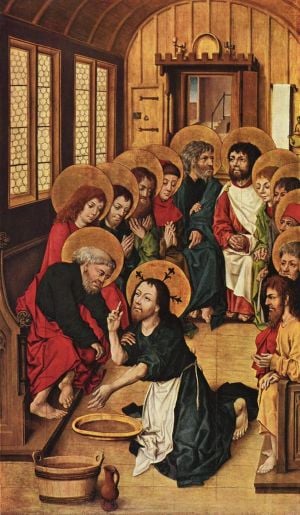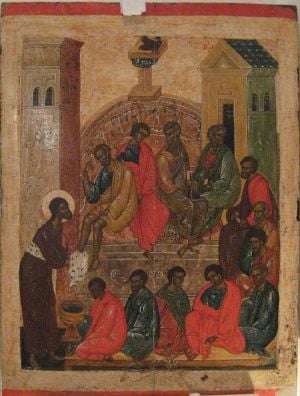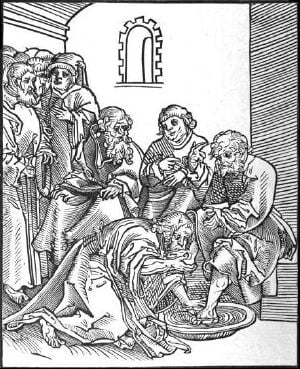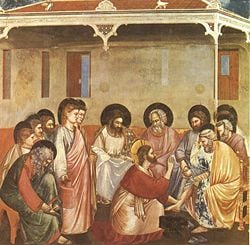Foot Washing

Foot washing (also known as pedilavium) is a religious rite observed by several faiths including Christianity, Islam, and Sikhism. Within Christianity, the practice derives from the scriptures of the New Testament (John 13:1-15; 1 Timothy 5:10) in which Jesus tells his followers to wash-each others' feet as a sign of humility and brotherhood. In fact, Jesus himself, washes the apostles' feet to exemplify humility and servitude.
The religious act of foot-washing is also practiced in Islam and Sikhism as part of ritual cleanliness. Within these religions, purity in worship is very important. Furthermore, in the predominantly Hindu culture of India, touching the feet of others is seen as a sign of respect.
History
The root of religious feet-washing appears to be found in the hospitality customs of ancient civilizations, especially where sandals were the chief footwear. A host would provide water for guests to wash their feet, serve the guests by washing their feet, or even provide a servant to wash the feet of the guests. This is mentioned in several places in the Old Testament of the Bible (for example, Genesis 18:4; 19:2; 24:32; 43:24; I Samuel 25:41; and so on), as well as other religious and historical documents. A typical host might bow, greet, and kiss his guest, then offer water to wash his feet.
Within Christianity, the rite of foot-washing appears to have been practiced in the early centuries of post-apostolic Christianity. Observance of foot washing at the time of baptism was maintained in Africa, Gaul, Germany, Milan, northern Italy, and Ireland. For example, Tertullian (145-220 C.E.) mentions the practice in his De Corona, but gives no details as to whom practiced it or how it was practiced. Evidence for foot-washing in the church at Milan is found in the Council of Elvira (300 C.E.), and is referenced by Augustine (c. 400 C.E.). Saint Benedict's Rule (529 C.E.) also prescribed hospitality feetwashing in addition to a communal feetwashing for humility."[1] The Albigenses observed feetwashing in connection with communion, and the Waldenses' custom was to wash the feet of visiting ministers. There is some evidence that it was observed by the early Hussites. Foot washing was often "rediscovered" or "restored" in revivals of Christianity in which the participants tried to recreate the faith and practice of the apostolic era. The practice was a meaningful part of the sixteenth century radical reformation.
Jesus' example
Foot washing is described in the scriptures of the Bible wherein Jesus instructs his followers to practice foot-washing as a sign of humility and brotherhood:
[Jesus] riseth from supper, and laid aside his garments; and took a towel, and girded himself. After that he poureth water into a bason, and began to wash the disciples' feet, and to wipe them with the towel wherewith he was girded. Then cometh he to Simon Peter: and Peter saith unto him, Lord, dost thou wash my feet? Jesus answered and said unto him, What I do thou knowest not now; but thou shalt know hereafter. Peter saith unto him, Thou shalt never wash my feet. Jesus answered him, If I wash thee not, thou hast no part with me. Simon Peter saith unto him, Lord, not my feet only, but also my hands and my head. Jesus saith to him, He that is washed needeth not save to wash his feet, but is clean every whit: and ye are clean, but not all. For he knew who should betray him; therefore said he, Ye are not all clean. So after he had washed their feet, and had taken his garments, and was set down again, he said unto them, Know ye what I have done to you? Ye call me Master and Lord: and ye say well; for so I am. If I then, your Lord and Master, have washed your feet; ye also ought to wash one another's feet. For I have given you an example, that ye should do as I have done to you. Verily, verily, I say unto you, The servant is not greater than his lord; neither he that is sent greater than he that sent him. If ye know these things, happy are ye if ye do them (Gospel of John, 13:1-15)
Another biblical version of Jesus washing the saints' feet is mentioned in I Timothy 5:10.
Practice
Roman Catholic practice
In Roman Catholic Church, the ritual washing of feet is now associated with the liturgy of Holy Thursday, the day that celebrates the Last Supper of Jesus, before which he washed the feet of his twelve apostles.
Evidence for the practice on this day goes back at least to the latter half of the twelfth century, when "the pope washed the feet of twelve sub-deacons after his Mass and of thirteen poor men after his dinner."[2]
From 1570 to 1955, the Roman Missal printed, after the text of the Holy Thursday Mass, a rite of washing of feet unconnected with the Mass. The 1955 revision by Pope Pius XII inserted it into the Mass. Since then, the rite is celebrated after the homily that follows the reading of the gospel account of how Jesus washed the feet of his twelve apostles (John 13:1-15). Some men who have been selected—usually twelve, but the Roman Missal does not specify the number—are led to chairs prepared in a suitable place. The priest goes to each and, with the help of the ministers, pours water over each one's feet and dries them. In the United States it is common to have a communal observance: Lay members of the congregation take turns washing one another's feet. There is some controversy, or at least variation in practice, as to whether this ritual should properly include laypeople, and if so, whether women should be excluded.[3]
At one time, most of the European monarchs also performed the Washing of Feet in their royal courts on Maundy Thursday, a practice continued by the Austro-Hungarian Emperor and the King of Spain up to the beginning of the twentieth century.

Eastern Orthodox and Byzantine Catholic
The Eastern Orthodox and Eastern Catholic Churches practice the ritual of the Washing of Feet on Holy and Great Thursday (Maundy Thursday) according to their ancient rites. The service may be performed either by a bishop, washing the feet of twelve priests; or by an Hegumen (Abbot) washing the feet of twelve members of the brotherhood of his monastery. The ceremony takes place at the end of the Divine Liturgy.
After Holy Communion, and before the dismissal, the brethren all go in procession to the place where the Washing of Feet is to take place (it may be in the center of the nave, in the narthex, or a location outside). After a psalm and some troparia (hymns) an ektenia (litany) is recited, and the bishop or abbot reads a prayer. Then the deacon reads the account in the Gospel of John, while the clergy perform the roles of Christ and his apostles as each action is chanted by the deacon. The deacon stops when the dialogue between Jesus and Peter begins. The senior-ranking clergyman among those whose feet are being washed speaks the words of Peter, and the bishop or abbot speaks the words of Jesus. Then the bishop or abbot himself concludes the reading of the Gospel, after which he says another prayer and sprinkles all of those present with the water that was used for the foot washing. The procession then returns to the church and the final dismissal is given.
Oriental Orthodox
Foot-washing rites are also observed in the Oriental Orthodox churches on Maundy Thursday.
In the Coptic Orthodox Church the service is performed by the parish priest, not just by a bishop or hegumen. He blesses the water for the foot washing with the cross, just as he would for blessing holy water and he washes the feet of the entire congregation.
Protestant practice
Foot washing is observed by numerous Protestant groups, including Pentecostal and Pietistic groups, some Anabaptists, and some Baptists. Though history shows that foot washing has at times been practiced in connection with baptism, and at times as a separate occasion, by far its most common practice has been in connection with the The Lord's supper service.

The observance of washing the saints' feet is quite varied, but a typical service follows the partaking of unleavened bread and wine. Deacons (in many cases) place pans of water in front of pews that have been arranged for the service. The men and women participate in separate groups, men washing men's feet and women washing women's feet. Each member of the congregation takes a turn washing the feet of another member. Each foot is placed one at a time into the basin of water, is washed by cupping the hand and pouring water over the foot, and is dried with a long towel girded around the waist of the member performing the washing. Most of these services appear to be quite moving to the participants.
Among groups that do not observe foot washing as an ordinance or rite, the example of Jesus is usually held to be symbolic and didactic. Among these groups, foot washing is nevertheless sometimes literally practiced. First, some reserve it to be a practice of hospitality or a work of necessity. Secondly, some present it as a dramatic lesson acted out in front of the congregation.
Foot washing rites are also practised by some Anglican, Lutheran and Methodist churches. For example, within the United Methodist Church, foot washing is most often experienced in connection with Maundy Thursday services and, sometimes, at ordination services where the Bishop may wash the feet of those who are to be ordained. The foot washing service is practiced regularly by members of the Seventh-day Adventist Church, Primitive Baptists, and the Church of God (Cleveland, Tennessee).
Non-Trinitarian Groups
In the Church of Jesus Christ of Latter-day Saints, foot washing has historically taken two forms. In 1830, founder Joseph Smith, Jr. directed missionaries, while proselytizing, to shake or wash the dust from their feet as a cursing against those who reject them. This was based on the New Testament practice outlined in Matthew 10:14 for early Christian apostles. In the mid-1830s, Smith also introduced a separate ordinance (ritual) of foot washing in the faith's temples as a ritual cleansing. This practice was later expanded and incorporated into the washing and anointing ceremony.
The True Jesus Church includes Footwashing as a scriptural sacrament based on John 13:1-11. Like the other two sacraments, namely Baptism and the Lord's Supper, members of the church believe that footwashing imparts salvific grace to the recipient—In this case, to have a part with Christ (John 13:8).
Foot-washing in Islam
Wudu (Arabic: الوضوء al-wuḍū, Persian:آبدست ābdast, Turkish: abdest, Urdu: وضو wazū) is the Islamic act of washing parts of the body using water. Muslims are required to perform wudu in preparation for ritual prayers and for handling and reading the Qur'an. Wudu is often translated as "partial ablution," as opposed to ghusl, or "full ablution."
The Qur'anic mandate for wudu comes in the sixth ayat of Surah 5 (Al-Ma'ida):
O you who believe! when you rise up to prayer, wash your faces and your hands as far as the elbows, wipe your heads and your feet to the ankles; and if you are under an obligation to perform a total ablution, then wash (yourselves) and if you are sick or on a journey, or one of you come from the privy, or you have touched the women, and you cannot find water, betake yourselves to pure earth and wipe your faces and your hands therewith, God does not desire to put on you any difficulty, but He wishes to purify you and that He may complete His favor on you, so that you may be grateful.
Notes
- ↑ New Advent, New Advent Catholic Encyclopedia: Washing of Feet and Hands. Retrieved August 17, 2008.
- ↑ Ibid.
- ↑ Catholic Online, Washing of the Feet on Holy Thursday. Retrieved August 10, 2008.
ReferencesISBN links support NWE through referral fees
- Arvigo, Rosita and Epstein, Nadine. Spiritual Bathing: Healing Rituals and Traditions from Around the World. Celestial Arts, 2003. ISBN 978-1587611704.
- Haeri, Shaykh Fadhlalla. The Thoughtful Guide to Islam. John Hunt Publishing, 2004. ISBN 978-1903816622.
- Insoll, Timothy. Archaeology and World Religion. Routledge; 1st ed., 2001. ISBN 978-0415221559.
- Jacolliot, Louis. The Brahmin's First Degree of Initiation: Ablutions, Prayer, Ceremonies, and Evocation. Kessinger Publishing, 2005. ISBN 978-1425307202.
- Lawrence, Jonathan David. Washing in Water: Trajectories of Ritual Bathing in the Hebrew Bible and Second Temple Literature (Sbl - Academia Biblica). Brill Academic Publishers, 2007. ISBN 978-9004146709.
- Peter Jeffery A New Commandment: Toward a Renewed Rite for the Washing of Feet. Liturgical Press, 1992. ISBN 978-0814620045.
- Pinson, J. Matthew. The Washing of the Saints' Feet. Randall House, 2006. ISBN 0-89265-522-4.
- This article incorporates text from the public-domain Catholic Encyclopedia of 1913.
Credits
New World Encyclopedia writers and editors rewrote and completed the Wikipedia article in accordance with New World Encyclopedia standards. This article abides by terms of the Creative Commons CC-by-sa 3.0 License (CC-by-sa), which may be used and disseminated with proper attribution. Credit is due under the terms of this license that can reference both the New World Encyclopedia contributors and the selfless volunteer contributors of the Wikimedia Foundation. To cite this article click here for a list of acceptable citing formats.The history of earlier contributions by wikipedians is accessible to researchers here:
The history of this article since it was imported to New World Encyclopedia:
Note: Some restrictions may apply to use of individual images which are separately licensed.


